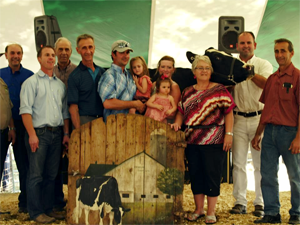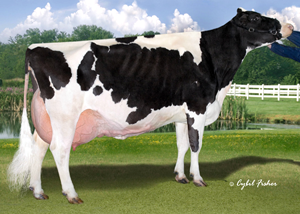Dairy breeding is about putting the right pairings together. It is also the formula for success that has worked more than once for photographer Han Hopman, one of the founders of Holstein International. He explains the beginning of his dual interests. “With my parents I always went on vacation to a dairy farmer. He always took me with him for milking and feeding the cows. I loved them. Back home in town again I missed them dearly. When I became 10 years old I asked for a camera to take pictures of the cows and glue them into a book. From that time I wanted to be a cow photographer.” Cameras and cows. Han can’t have one without the other.
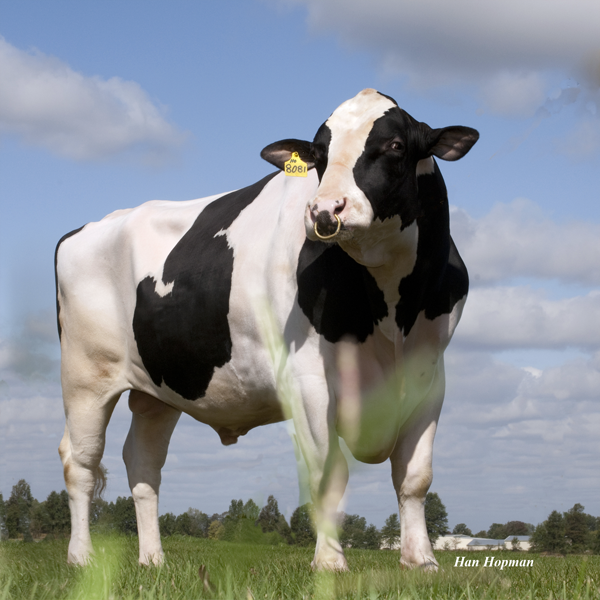
Han Hopman has captured some of the greatest bull shots in history, including this one of Ensenada Taboo Planet
Mission Possible: Write On! Great pics! From Cover to Cover
Han’s passion for cows was later enhanced by collaboration with Jan Bierma. “We were already making articles for several magazines like Holstein World, Holstein Journal, Typex in France, Bianco Nero in Italy and Veeteelt in the Netherlands and a few more. In Holstein World we had the Euroworld section. We published in that section information about bulls and genetics from Europe. When we had to stop that because of political reasons, we decided to start our own international magazine.” In 1994 they founded Holstein International in the Netherlands. Because of their professions Jan Bierma took on the editorial part of the magazine while Han took over the photography. Another great pairing.

Special presentation by Han Hopman (holding camera) and Jan Bierma (left) to Barry Slack and Charlie Will of Select Sires.
Quantum of Success
 Hopman and Bierma already shared the bonds of friendship and commitment to Holsteins and it soon became obvious how well their words and pictures would continue the complementary relationship. “We have made Holstein International as it is now. One of the most important and leading Holstein Magazines in the World. The only independent unbiased magazine in the world, which is published in six different languages in over 60 countries. And all the information so up to date!” They have come a long way as Han marvels, “I didn’t foresee this when we started in 1994.”
Hopman and Bierma already shared the bonds of friendship and commitment to Holsteins and it soon became obvious how well their words and pictures would continue the complementary relationship. “We have made Holstein International as it is now. One of the most important and leading Holstein Magazines in the World. The only independent unbiased magazine in the world, which is published in six different languages in over 60 countries. And all the information so up to date!” They have come a long way as Han marvels, “I didn’t foresee this when we started in 1994.”
The Incredible Shrinking World – Cows Unlimited
During the nineteen years spanned by their publication, Holstein dairy breeding has gone from primarily a country-by-country breeding focus to a global panorama where the Holstein breed is international in every way. “When we started HI, global breeding was just beginning. Every country was on its own. Now days you can use almost every bull you want and use every cow family you like – from anywhere in the world. The breeding world has become one big country. I think this is the biggest change I have seen. It has helped the industry a lot.” Han is happy with these changes and proudly affirms, “I am sure Holstein International did a good job to speed up this process!”

Han Hopman has captured some of the most iconic images in the dairy industry. Including this shot of the great Harvue Roy Frosty.
Genomics Isn’t a ‘Point and Shoot’ Solution
Han urges caution when incorporating new and exciting changes such as the ones coming about with Genomics. He advises. “Genomics is a good tool for a breeder. But only a few parts are known.” It is the unknown that concerns him. “What is the influence of linking genes? We don’t know yet but we act as if we know everything about it.” He has concerns for the future. “We have to take care that we do not destroy our breed by using genomic bulls on daughters of genomic bulls who don’t have a daughter-proof yet. It is a pity if we destroy what breeders like Pete Heffering, Frank Reagan and others like them have built up for us.” The worst case scenario for Han would be, “Mating purely on genomics (because that) has nothing to do with breeding any more. It is multiplying the ‘highest bull with the highest heifer’. A pity.”

Always catching the moment this is a great teamwork shot by Han Hopman.
The “BIG” Picture is Changing Focus
Han anticipates that other changes will also be coming into view. “In the long run I think that small farms cannot survive and that there will be more and bigger farms.” These evolving changes will be impacted by many other things as Han points out “Land will be expensive and also the costs of transporting food will increase.” He foresees major changes ahead for the cows he loves. “Genetics technology will have a big influence on our Holstein population. Genomics in the future will have more and more reliability. If that is true, then you will see a larger difference between farms who have cows to produce milk and farms who produce the animals for the next generation. So the whole set up of the industry will change when genomics becomes more reliable.”

Han Hopman’s great passion is catching dairy cattle in their natural state.
Shooting Stars – Naturally
From the very beginning Han has enjoyed taking pictures of cows in a natural setting. “I started as a side shot photographer but my passion is to picture them as relaxed as possible. It is nice to make a natural shot of a cow. To picture her in a way that you can see from the picture that she is happy or at least fully herself. If you can catch that moment, it gives me a happy feeling. And it is nice that I have my own magazine, which is a beautiful podium to publish these kinds of pictures.”

Han Hopman always get’s his shot including this one of Eastside Lewisdale Goldwyn Missy & RF Goldwyn Hailey, Grand Champion and Reserve Grand Champion at Royal Winter Fair 2011.
You Only Love Once – Get It on Film
Han loves his work and has advice for others. “Do what you like and love. You only live once! I loved cows as a child and got homesick when I wasn’t with them. Now I have the best job in the world. I have my own cow magazine and travel a lot around the world to visit the most important herds of the world and see the most beautiful cows.”
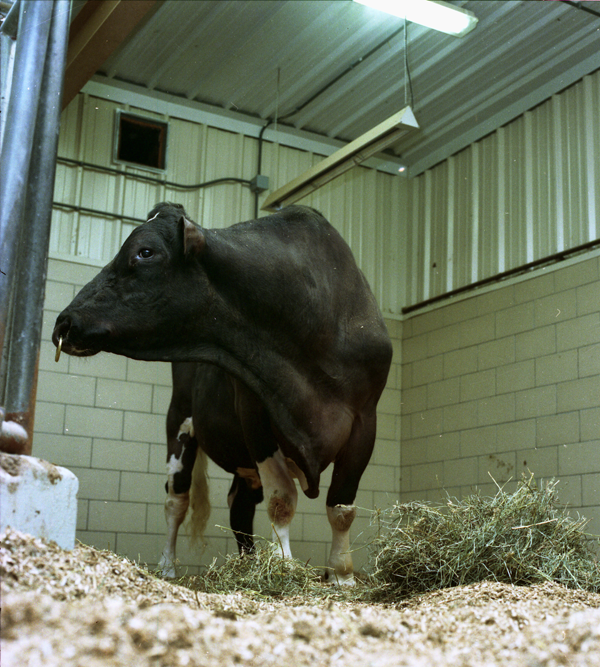
Han Hopman pictured To-Mar Blackstar pictured a few weeks before Blackstar died.
Photographic memory: Once More with Feeling
Such enthusiasm and dedication has undoubtedly produced a huge portfolio of images. Han has an evolving list of favorites. He says, “For a long time it was the picture of Blackstar. I pictured him a few weeks before he died in his box. He was my first important American bull that I pictured. I was so proud that I got the opportunity to do that. Charley Will from Select Sires made it happen for me and I am still thankful for that.” New pictures are always rising up his list. “At the moment it is the picture of Planet. In the picture you can see who he is. And such an important bull at the moment!” Han speaks emotionally of a picture he took last year at Omaha Beach. “Just a cow with a beautiful girl. It was the place where D-day started and you could still feel the atmosphere of the awful things that happened there. So many young people killed. The picture is very serene. And the interaction between the woman and the cow was so special. It looks as if they are alone in the world. A great moment which I never will forget!”
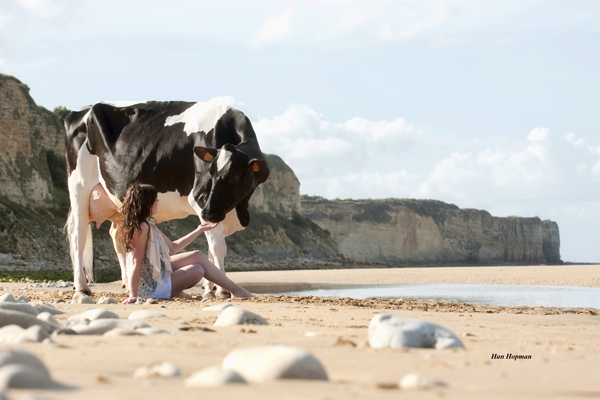
The Bullvine Bottom Line: Aim High
Han has discovered much wisdom from his chosen breed and chosen career. “There are so many small lessons I have learned through the years. The biggest one is that it is better to cooperate with your competitors than to compete with them.” That’s a lesson we can all benefit from. However Han feels his greatest life lessons are owed to his friend. “Jan Bierma, taught me what friendship means and from him I learned the passion to make a magazine.” As they head into their third successful decade, we thank Han for sharing with the Bullvine. “All the best as you continue to aim HI.”
![]()
Get a free copy of Holstein International.





